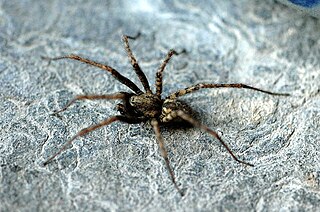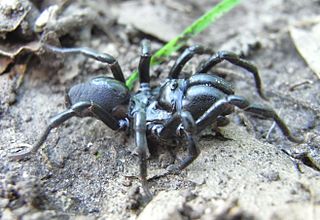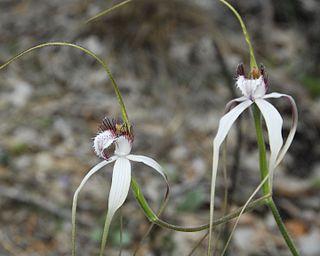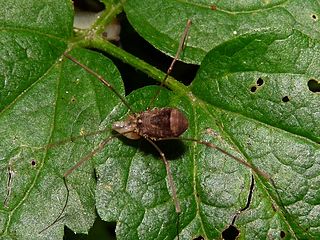
Atypidae, also known as atypical tarantulas or purseweb spiders, is a spider family containing only three genera. They are accomplished ambush predators that spend most of their time in a sock-like, silken retreat on the ground from where they kill their prey.

The spider species Tegenaria domestica, commonly known as the barn funnel weaver in North America and the domestic house spider in Europe, is a member of the funnel-web family Agelenidae and a close relative of the hobo spider.

Nuctenea umbratica, the walnut orb-weaver spider, is a species of spider in the family Araneidae.

Araniella cucurbitina, sometimes called the "cucumber green spider", is a spider of the family Araneidae.

Tegenaria ferruginea or charcoal spider is a European reddish, rather common spider with rusty markings on its back. The body looks rather similar to T. parietina, however the legs are much shorter and the funnel web built lacks backdoor exit. It was transferred to Malthonica in 2005, but back to Tegenaria in 2013.

Ozyptila praticola is a species of crab spider found throughout Europe and the Middle East. Females reach up to 4 mm, males grow up to 3 mm. Both sexes are of a dark reddish brown. It hunts primarily in the undergrowth, but can also be found under the bark or on the lower branches of trees. This is also where the female deposits and guards its egg sac. Adults can be found most of the year.

Sphodros is a genus of North American purseweb spiders first described by Charles Athanase Walckenaer in 1835. It was considered a synonym of Atypus until 1980.

Sphodros rufipes, sometimes called the red legged purseweb spider, is a mygalomorph spider from the southern United States, though it has been photographed as far north as Indiana, Missouri, New Jersey, Minnesota, Tennessee, Delaware, Louisiana, and Tuckernuck Island in Massachusetts. A recent sighting shows that these spiders can also be found in Canada. Recent sighting also in Kansas

Atypus affinis, the purseweb spider, is a common mygalomorph spider from Europe.

Atypus karschi is a mygalomorph spider found in Japan, China, and Taiwan.

Atypus piceus is a mygalomorph spider of the family Atypidae. It occurs in Europe to Moldavia, and Iran and is the type species of the genus Atypus.

Isopogon adenanthoides, commonly known as the spider coneflower, is a plant in the family Proteaceae and is endemic to the southwest of Western Australia. It is an erect shrub with sharply-pointed, trifid leaves and spherical heads of pink flowers.

Caladenia longicauda is a species of plant in the orchid family Orchidaceae and is endemic to the south-west of Western Australia. It is distinguished by its large leaf and by its up to five large, white flowers which have drooping sepals and petals with long, thickish brown "tails".

Tetragnatha extensa is a species of spider found across the Northern Hemisphere. It has an elongate body, up to 11 mm (0.43 in) long, and adopts a straight line posture when alarmed. It lives on low vegetation in damp areas, and feeds on flying insects which it catches in its web.
Dipogon bifasciatus is a spider wasp from the family Pompilidae.

Aporus unicolor, common name cutpurse, is a highly specialised spider hunting wasp from the family Pompilidae.

Leiobunum blackwalli is a species of harvestman. It is found in Europe.

Trogulus tricarinatus is a species of harvestman. It is found in Europe and North America.
Atypus snetsingeri is a species of purseweb spider in the family Atypidae. It is found in the United States.
















